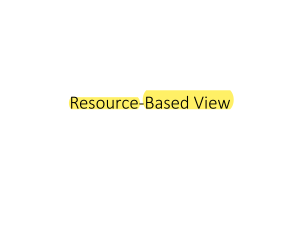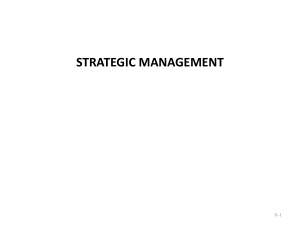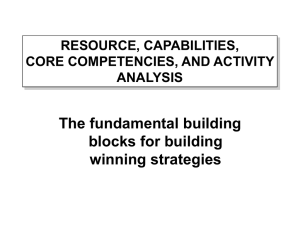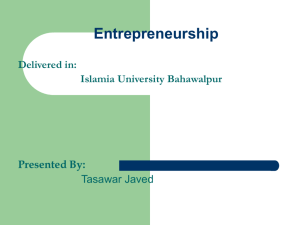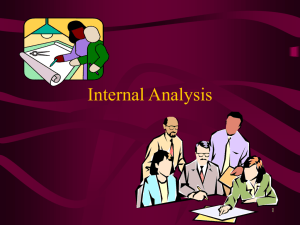Business Terms & Concepts
advertisement
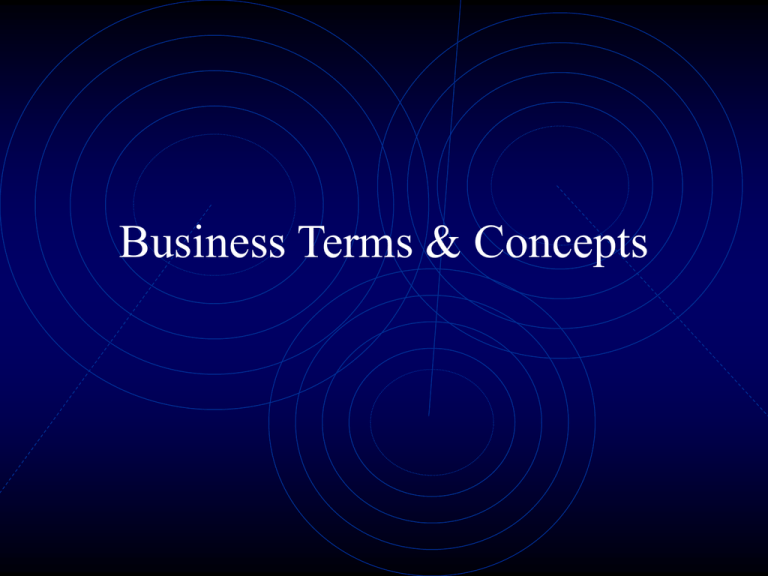
Business Terms & Concepts Some Basic Definitions • An organization is a group of people within some structure who possess a common objective, usually expressed in a mission statement. • Organizations may be: • for profit (frequently referred to as “firms”) • not-for-profit • A market is a place (real or virtual) where potential sellers and buyers meet to exchange resources (which may be money, products, services, etc.). • An industry is a group of organizations competing in a predefined market under similar bases of competition General Bases of Competition • A “basis of competition’ is a dimension upon which companies choose to compete, e.g., • • • • • • • Price Quality Delivery Service Innovation Knowledge Others? Organization and Environment • An organization operates within an environment that is in a constant state of change • Too often we hear of change and its effects, but exactly what can change? The Organization and Its Environment Global Public pressure groups The Specific Environment Suppliers The Organization Customers Government Competitors The General Environment Figure 3-4 Management (5th ed.) Robbins and Coulter Prentice Hall Objective(s) of the Firm • What is the objective of the firm? • Maximize shareholder wealth • Generate above average economic rents (profits) • Shareholder: Someone who holds stock (ownership) in the firm. • Stakeholder: Anyone who possesses an interest in the firm’s activities (govt., public pressure groups, alumni, students, etc.) Strategy • To meet the organization’s objective, managers craft a strategy. What’s a strategy? • The science of planning and directing large-scale operations, of maneuvering forces into the most advantageous position prior to actual engagement with the enemy (Webster) • A strategy is a plan to marshall or deploy scarce resources. (Simpler) • Levels of strategy: • Corporate (Portfolio management) • Business (Generate sustainable competitive advantage) • Functional (Support the business level strategy) Corporate-Level Strategy • Diversification: the minimization of cash flow variance • Integration • Forward integration (one type of vertical): • Gaining ownership or increased control over distributors or retailers (UA buys Priceline) • Backward integration (the other): • Gaining ownership or increased control over suppliers (Amazon buys RCA records) • Horizontal integration • Seeking ownership or increased control over competitors (Amazon buys BestBookBuys.Com) • Also approving (but not crafting) business-level strategies Business-Level Strategy • The primary objective of business-level strategy is to create sources of sustainable competitive advantage. • OK… what is sustainable competitive advantage? • There are many definitions, used by different people in different ways. • Here is a practical description. But first, we have to back up… Sustainable Competitive Advantage • An asset is anything the firm owns or controls. • Loosely, “Asset” is to Accounting as “Resource” is to Management. • Types of assets: • Physical: plant equipment, location, access to raw materials • Human: training, experience, judgment, decision-making skills, intelligence, relationships, knowledge • Organizational: Culture, formal reporting structures, control systems, coordinating systems, informal relationships Sustainable Competitive Advantage • A capability is usually considered a “bundle” of assets or resources to perform a business process (which is composed of individual activities) • • All firms have capabilities. However, a firm will usually focus on certain capabilities consistent with its strategy. • • E.g. The product development process involves conceptualization, product design, pilot testing, new product launch in production, process debugging, etc. For example, a firm pursuing a differentiation strategy would focus on new product development. A firm focusing on a low cost strategy would focus on improving manufacturing process efficiency. The firm’s most important capabilities are called competencies. Competencies vs. Core Competencies vs. Distinctive Competencies • A competency is an internal capability that a company performs better than other internal capabilities. • A core competency is a well-performed internal capability that is central, not peripheral, to a company’s strategy, competitiveness, and profitability. • A distinctive competence is a competitively valuable capability that a company performs better than its rivals. Examples: Distinctive Competencies • Sharp Corporation • • Toyota, Honda, Nissan • • Low-cost, high-quality manufacturing capability and short design-to-market cycles Intel • • Expertise in flat-panel display technology Ability to design and manufacture ever more powerful microprocessors for PCs Motorola • Defect-free manufacture (six-sigma quality) of cell phones Where are we? • We are discussing sustainable competitive advantage. Here we are now: • AssetsCapabilitiesCompetenciesCompetitive Advantage • Next is competitive advantage. • A competitive advantage is simply an advantage you have over your competitors. • A competency will produce competitive advantage provided: A) it produces value for the organization, and B) it does this in a way that cannot easily be pursued by competitors. Sustainable Competitive Advantage • However, we said the primary objective of business-level strategy was to create sources of sustainable competitive advantage (SCA). • How do we know SCA when we see it? What is it? When is it considered “sustainable”? • To produce SCA, the capability must: • • • • Produce value Be rare Not be easily imitated or substituted Be exploitable by the organization Sustainable Competitive Advantage • The Question of Value: • Value is dependent on type of strategy: • Low cost strategy: lower costs (Timex) • Differentiator: add enhancing features (Rolex) • To be valuable, the capability must either • Increase efficiency (outputs / inputs) – Information system reduces customer service agents required, or increases the number of calls the same number of agents can answer • Increase effectiveness (enable some new capability not previously held) – Opening a new regional campus enables outreach to a new market of students Sustainable Competitive Advantage • The Question of Rareness: • Given the following, which are rare? • A web server • An MIS instructor • A state-of-the-art stamping press • None of these are rare. Some researchers think only organizational assets or resources are rare (such as culture). What do you think? Sustainable Competitive Advantage • The Question of Imitability (how easily the capability can be imitated by competitors): • Ways capabilities can be imitated: • Duplication: purchase / develop similar capabilities (R&D dept. for R&D dept.) • Substitution: e.g. a superior marketing strategy for a brand name; a superior technical support group for an intelligent diagnostic software package • Ways imitation can be avoided: • Unique Historical Conditions (Caterpillar, e.g.) • Social Complexity (trust, teamwork, informal relationships, causal ambiguity where cause of effectiveness is uncertain) Sustainable Competitive Advantage • The Question of Exploitation: • Is a firm organized to exploit the full competitive potential of its resources and capabilities? • Are systems in place to enable firms to support the execution of a particular strategy? • Xerox, e.g Summary • The primary objective of business strategy is to generate sources of sustainable competitive advantage • Based on all these criteria, you probably see that this is very difficult and rare • Sustainable • Not based on calendar time • It means your competitors not only try to compete with you and fail, but also they stop trying to compete with you altogether • What implications are there for E-Commerce? • ECT 555, Design / Strategies for E-Commerce
